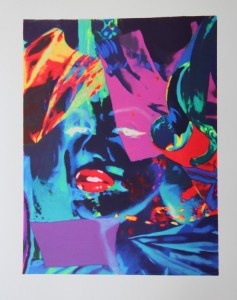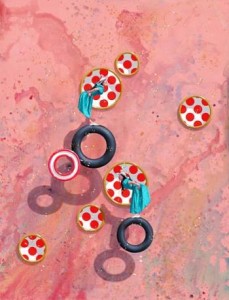Our last blog touched on some common types of print mediums. Today, we’ll be focusing on one specific type of print medium: serigraphy. Serigraphy is a very unique type of printmaking that involves stenciling individual colors on separate layers of silk or polyester fabric. We recently added a new serigraph to our collection; Yuroz’s “Dance with the Pomegranates” was created by layering several different shades of color over a single canvas, then finishing with gold leaf. The process of making a traditional serigraph such as this is very detailed and time-consuming. It can take up to 2,000 hours to create a 100-color serigraph! Let’s go deeper and look into the steps for creating a serigraph.
C Print
After receiving the original artwork, the studio that makes the serigraph will have a professional photographer create a C Print. This is a copy of the artwork that has been enlarged to scale so that the artists in the studio can create a bigger version of the original artwork.
Mylar
After receiving the C Print, a professional chromist places a mylar, which is a strong and fine sheet of polyester or plastic, over the C plate, which is a plate that holds the C Print in place. The chromist then draws on the mylar with india ink, china marker, or opaque paint. He or she draws only the parts of the artwork that is for a single, individual color. Several layers of mylars are completed until every color in the artwork has its own mylar.

James Gill uses serigraphy to make lumnescent, photography-inspired images with colors that pop.
Silkscreen
A silk or polyester screen is coated with a photographically-sensitive emulsion, then stretched across a frame. The first sheet of mylar is attached to the silkscreen, and then they are both secured to an exposing unit that exposes the silkscreen to high-intensity light. This light hardens the photographically-sensitive emulsion except where the mylar is blocking the light. The silkscreen is then washed and ready to have paint or ink applied.
Ink
From about 15 basic colors, a professional color mixer creates the exact colors needed to replicate the original artwork. This process is done by hand and left to the discretion and artistic touch of the color mixer. Pure pigment is mixed with glaze to create a luminosity that is the hallmark of a handmade serigraph. After the right colors are created, the silkscreen is ready to be printed.
Printing
The silkscreen–which, by now, has been prepared for printing with the application of the mylars and high-intensity light–is ready to be printed. Each layer of color is applied individually in layers until the serigraph is completed. However, each layer of paint or ink must be allowed to completely dry before creating the next layer. Thus, a maximum of two layers of color can be added each day. About every 15 colors, the printmakers will send a proof to the artist to approve before continuing with the printing process. This is why serigraphs are so labor- and time-intensive. However, the end result is a luminous, detailed artwork that is true to the artist’s original. The painstaking work and long, arduous process is evident in the final result.

Philippe Bertho’s Marie qui se Cherche is toned down in comparison to Bertho. However, the colors and details show a very deliberate style of serigraphy.
Keep up with our blog for the latest art news.
Questions? Call Patty Barnett at 504.524.2922
Like us on Facebook , follow us on Twitter and share with your friends.
Tags: print mediums, serigraphs






